home vintage cameras index
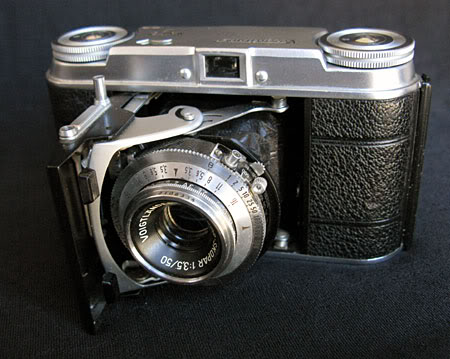
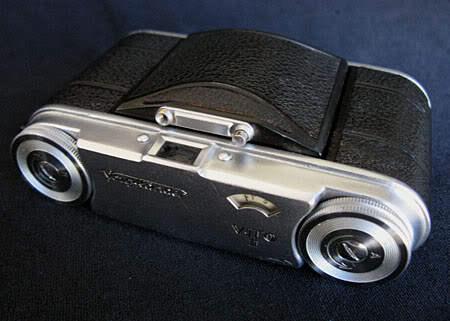

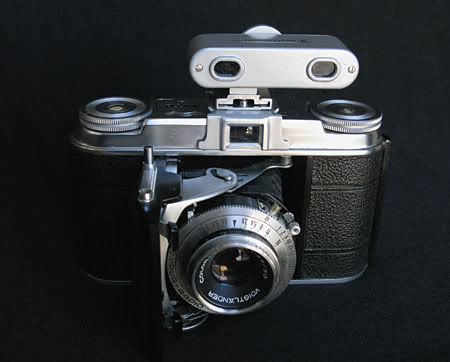
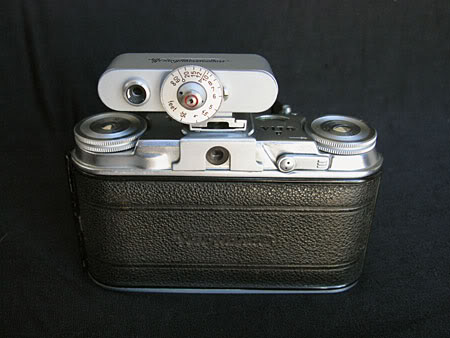
The Vito II user manual is at the Butkus site.
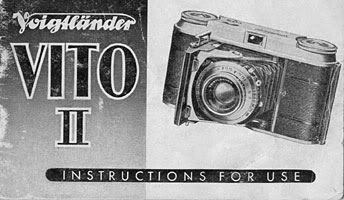
The first model Vito appeared in the 1930s. Mine are all post-war models from the '50s; by that time, their style is a bit more sleek in conformity with the tastes of what was then called the "Jet Age". The Color Skopar lens, with four-elements in three-groups, is said to be a recomputed Tessar design and also includes a beautiful saphire-blue anti-reflective coating on the lens surfaces. The Prontor shutter on my first Vito has a top speed of just 1/300, but it is reliable and extremely quiet in operation. The advance mechanisms are simple and robust. In all models, the frame counter and double-exposure prevention feature are driven by a gear advanced by the moving film sprocket holes, so the shutter won't trip without film in the camera.
 The sturdy construction of the Vito II ensured a long life, and servicing an old one often means nothing more than superficial cleaning. If more is required, the shutters will look familiar to anyone who has peeked inside any of the classic German cameras, though getting to them will require some ingenuity or specialized tools. To screw off the silver metal cap ring at the front of the lens mount, one must first get a grip on the black ring behind it which carries the distance scale markings. The best way to manage this is probably to use a couple flexiclamps like the ones I acquired from Micro-Tools. A 1-3/16" clamp fits the distance scale ring, while a 1-1/8" clamp rotates off the top cap ring in a counter-clockwise direction. In order to get a sufficiently tight grip to turn off the top ring, I found it necessary to apply a pair of vice-grip pliers midway on the top flexiclamp. With the two rings and the cone-shaped logo piece out of the way, there is seen a cover plate with three screws which secures the infinity adjustment of the front lens element. Taking off the adjustment plate allows removal of the front lens and access to the shutter mechanism.
The sturdy construction of the Vito II ensured a long life, and servicing an old one often means nothing more than superficial cleaning. If more is required, the shutters will look familiar to anyone who has peeked inside any of the classic German cameras, though getting to them will require some ingenuity or specialized tools. To screw off the silver metal cap ring at the front of the lens mount, one must first get a grip on the black ring behind it which carries the distance scale markings. The best way to manage this is probably to use a couple flexiclamps like the ones I acquired from Micro-Tools. A 1-3/16" clamp fits the distance scale ring, while a 1-1/8" clamp rotates off the top cap ring in a counter-clockwise direction. In order to get a sufficiently tight grip to turn off the top ring, I found it necessary to apply a pair of vice-grip pliers midway on the top flexiclamp. With the two rings and the cone-shaped logo piece out of the way, there is seen a cover plate with three screws which secures the infinity adjustment of the front lens element. Taking off the adjustment plate allows removal of the front lens and access to the shutter mechanism.
The shutters on mine fortunately did not require more than superficial cleaning with some lighter fluid, so I did not remove the middle and rear lens groups. If necessary, the whole shutter assembly and the rear lens can be gotten out by the use of a suitable lens spanner. The middle lens group is a trickier prospect as it is housed in a threaded brass mount which can become stuck very solidly in place over the years. Applying too much force with an inappropriate tool can easily deform the brass mount, and the middle group will then not be able to be screwed back in.
Getting the top deck off the camera is uncomplicated. Taking off the advance and rewind buttons reveals a couple small screws; just take those out and lift off the top cover. There is no need to unscrew the rotating film release lever. The underlying gear train is robust and unlikely to need any attention. However, getting the top off will allow one to get easily inside the viewfinder housing to clean the lenses.
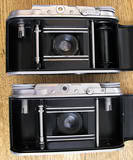 Someone asked me quite a while ago how he might acquire a take-up spool for a Vito II. I didn't know what to make of the question then because my first Vito had a fixed-in-place spool. One of my recently acquired cameras however, had no spool. The advance knob just has a forked shaft that looks the same as the supply side. To run my first roll of film through the camera, I inserted a plastic spool which I borrowed from a Contaflex, and that seemed to work fine. I was tempted to take the fixed spool mechanism from my first camera to put in the newer one as it will easily fit, but I decided that repairing something not broken was likely not a good idea. I did steal the rewind knob off my older Vito for use on one of the new ones which lacked it, and I also replaced a missing light seal on the back at the hinge.
Someone asked me quite a while ago how he might acquire a take-up spool for a Vito II. I didn't know what to make of the question then because my first Vito had a fixed-in-place spool. One of my recently acquired cameras however, had no spool. The advance knob just has a forked shaft that looks the same as the supply side. To run my first roll of film through the camera, I inserted a plastic spool which I borrowed from a Contaflex, and that seemed to work fine. I was tempted to take the fixed spool mechanism from my first camera to put in the newer one as it will easily fit, but I decided that repairing something not broken was likely not a good idea. I did steal the rewind knob off my older Vito for use on one of the new ones which lacked it, and I also replaced a missing light seal on the back at the hinge.
Shooting a fully manual camera with no rangefinder takes a little getting used to, but it is really more a matter of familiarity than of limitations. I have successfully shot many pictures at the closest focus setting with the Vito. For everything else, keeping the aperature at f8 or smaller and setting the focus to the optimum depth of field mark at about ten feet really produces sharp images every time. The last of the Vito II cameras were equipped with an accessory mount on the top deck which easily allowed the use of an accessory viewfinder. None of my Vito's came with the integral mount, but one does have a clip-on that lets me slide an elegant little Voigtländer rangefinder in place. Needing reading glasses as I do for close-up work, however, I have found the use of the rangefinder to be less than useful; by the time I have my glasses off and on to read and then set the proper distance, my chances to catch the desired scene have usually evaporated.
The Vito II easily found a spot in my camera bag on a 2005 trip to Greece with a stop-over in New York City. Most of the pictures I made on that trip and all the color shots were done with the handy little Voigtländer.

A Vito II Portrait
| The thumbnail images below link to Photo.net presentation pages which will open in a new browser window. | |||
 New York City |
 Athens |
 Rhodes |
 Symi |
home vintage cameras index
 © mike connealy
© mike connealy